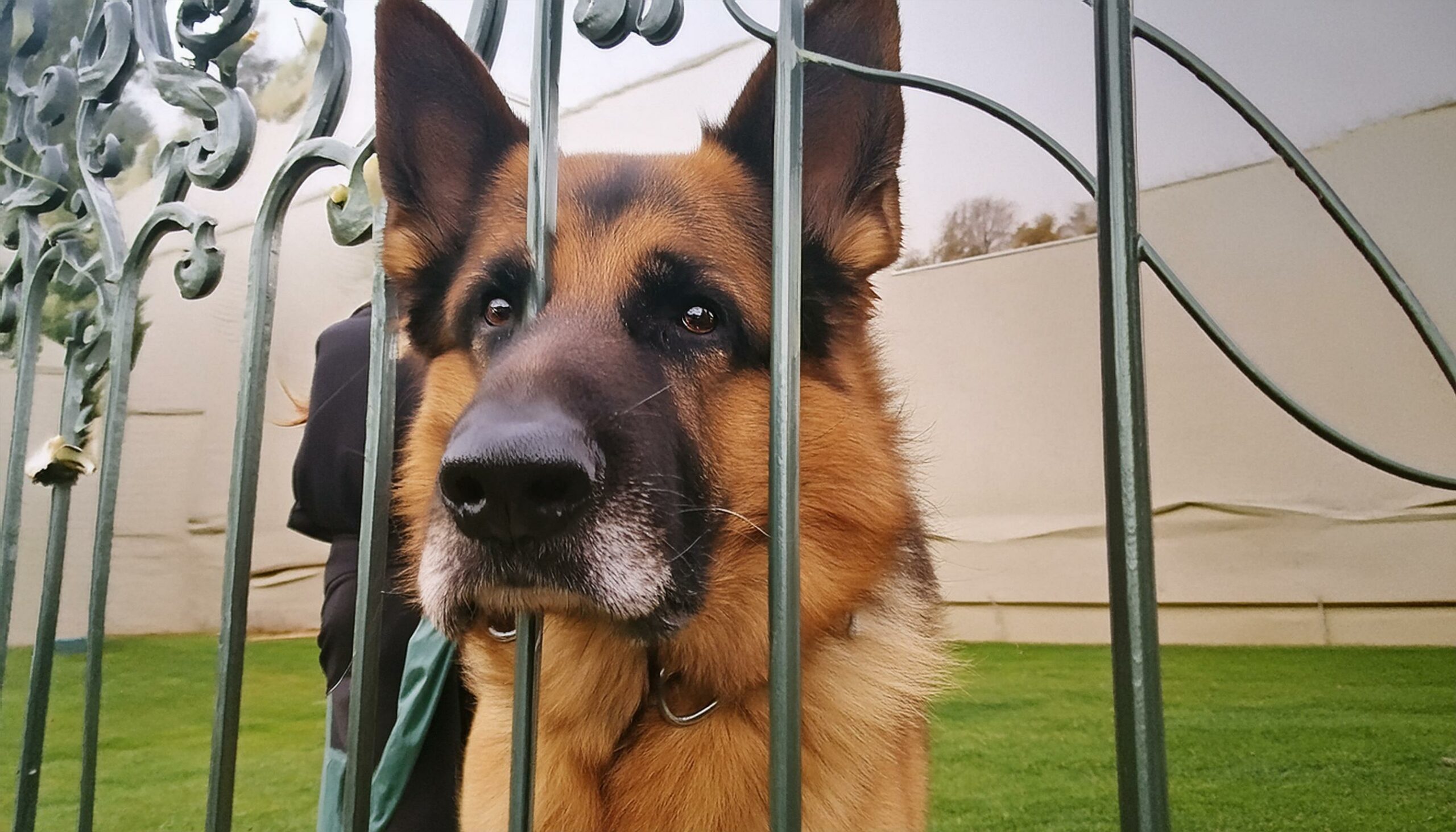German Shepherds are renowned for their loyalty and protective instincts, making them popular choices as family pets and working dogs. Understanding whether your German Shepherd is protective of you is crucial for nurturing a healthy relationship and managing their behavior effectively.
Understanding German Shepherds:
History and Origin: German Shepherds originated in Germany in the late 19th century, initially bred for herding sheep. They were developed by Max von Stephanitz, who aimed to create a versatile working dog with intelligence, strength, and loyalty. Over time, they evolved into one of the most recognized and beloved dog breeds worldwide.
Traits and Characteristics: German Shepherds exhibit a wide range of traits that make them exceptional companions and working dogs. They are known for their intelligence, courage, and versatility, excelling in various roles such as police work, search and rescue, therapy assistance, and competitive obedience. Additionally, they possess a strong sense of loyalty and devotion to their owners, often forming deep bonds with their families.
Signs Your German Shepherd is Protective:
Body Language Cues: A protective German Shepherd may display various body language cues to indicate their protective instincts. These cues include standing tall with ears erect, raised hackles along the back, and a focused gaze directed towards potential threats. Additionally, they may position themselves between you and perceived dangers, demonstrating a willingness to protect and defend you.
Vocalizations: Another sign of protectiveness in German Shepherds is vocalizations such as barking or growling in response to unfamiliar people or noises. While barking can serve as a warning signal to alert you of potential threats, excessive or incessant barking may indicate heightened anxiety or overprotectiveness. It’s essential to pay attention to the context of your dog’s vocalizations and assess whether they are responding to genuine threats or perceived dangers.
Bonding and Attachment:

Instinctual Behavior: Protective instincts are deeply ingrained in the genetic makeup of German Shepherds, stemming from their origins as herding and guarding dogs. Historically, they were tasked with protecting livestock from predators and intruders, requiring them to be vigilant and responsive to potential threats. This instinctual behavior has been passed down through generations, manifesting in their instinct to protect their families and territories.
Socialization: Early socialization plays a crucial role in shaping a German Shepherd’s behavior and temperament, including their level of protectiveness. Exposing them to various people, animals, environments, and experiences at a young age helps them develop confidence, resilience, and appropriate social skills. Proper socialization also teaches them to distinguish between friend and foe, reducing the likelihood of fear-based aggression or overprotectiveness towards harmless individuals.
Protective Training:
Importance of Training: Training is essential for channeling a German Shepherd’s protective instincts in a positive and constructive manner. It provides them with guidance, boundaries, and expectations, helping them understand how to behave appropriately in different situations. Moreover, training strengthens the bond between you and your dog, fostering mutual trust, respect, and communication.
Methods and Techniques: When training a German Shepherd for protective behavior, it’s crucial to use positive reinforcement techniques that reward desirable behaviors while discouraging undesirable ones. This involves praising and rewarding calm, composed behavior, such as alertness without aggression, and redirecting or ignoring unwanted behaviors. Consistency, patience, and clear communication are key to effective training, as German Shepherds thrive on structure and consistency.
Handling Protective Behavior:
Positive Reinforcement: Positive reinforcement is a powerful tool for shaping and reinforcing protective behavior in German Shepherds. By rewarding them with treats, praise, or toys for displaying appropriate responses to perceived threats, you can encourage them to remain calm, composed, and focused on you as their leader. Consistency and timing are critical when using positive reinforcement, as it helps your dog associate their actions with positive outcomes.
Setting Boundaries: Establishing clear boundaries and rules is essential for managing and controlling protective behavior in German Shepherds. This includes teaching them basic obedience commands, such as “sit,” “stay,” and “leave it,” as well as setting limits on their interactions with strangers or unfamiliar situations. Consistent enforcement of boundaries helps your dog understand what is expected of them and reduces the likelihood of overprotectiveness or aggression.
Building Trust:

Consistency: Consistency is key when building trust and confidence in your relationship with your German Shepherd. Consistent training, routines, and expectations create a sense of stability and predictability for your dog, helping them feel secure and reassured in their environment. Additionally, consistent leadership and guidance from you establish you as their pack leader, earning their respect and obedience.
Building Confidence: Building your German Shepherd’s confidence is essential for reducing fear-based aggression and overprotectiveness. This involves exposing them to various stimuli, environments, and experiences in a controlled and positive manner, gradually increasing their confidence and resilience. Confidence-building activities such as obedience training, agility courses, and interactive play provide mental stimulation and physical exercise, promoting overall well-being and emotional stability.
Common Misconceptions:
Aggression vs. Protection: One common misconception about German Shepherds is that their protective behavior is synonymous with aggression. However, there is a clear distinction between protective behavior, which is proactive and focused on preventing harm, and aggression, which is reactive and driven by fear, anxiety, or dominance. It’s important to recognize and understand the difference between these behaviors to effectively manage and address them.
Breed Stereotypes: German Shepherds are often stereotyped as aggressive or dangerous dogs due to their protective instincts and powerful appearance. However, these stereotypes are often unfounded and unfair, as individual temperament and behavior are influenced by factors such as genetics, upbringing, and socialization. Responsible ownership, proper training, and positive experiences can help dispel these stereotypes and promote a more accurate understanding of the breed.
Benefits of a Protective German Shepherd:
Security: One of the primary benefits of having a protective German Shepherd is the sense of security and peace of mind they provide. Their vigilant nature and unwavering loyalty make them excellent guardians for your home and family, deterring potential intruders and providing an extra layer of protection against threats.
Companionship: Beyond their protective instincts, German Shepherds are affectionate and loyal companions, forming deep bonds with their owners and families. Their unwavering devotion and companionship enrich your life and provide emotional support, companionship, and unconditional love. Whether snuggled up on the couch or accompanying you on outdoor adventures, your German Shepherd will be your steadfast companion through thick and thin.
Conclusion:
Understanding and nurturing your German Shepherd’s protective instincts is essential for fostering a harmonious relationship built on trust, respect, and mutual understanding. By recognizing the signs of protectiveness, implementing positive training techniques, and establishing clear boundaries, you can encourage healthy protective behavior while addressing any potential issues or concerns. Remember that each dog is unique, and patience, consistency, and positive reinforcement are key to developing a strong bond and a happy, well-adjusted companion.
FAQs:
- How can I differentiate between protective behavior and aggression in my German Shepherd?Protective behavior is characterized by vigilance, alertness, and a focused response to potential threats, whereas aggression is often accompanied by fear, hostility, and unpredictability. Pay attention to your dog’s body language, vocalizations, and overall demeanor to distinguish between the two.
- At what age does a German Shepherd start showing protective instincts?Protective instincts typically begin to emerge as German Shepherds mature, usually around 12 to 18 months of age. However, individual dogs may vary in their development, and early socialization and training play a significant role in shaping these instincts.
- Can I train my German Shepherd to be less protective?While it’s essential to manage and control protective behavior, attempting to suppress it entirely can be counterproductive. Instead, focus on training techniques that promote calmness, obedience, and positive interactions, allowing you to redirect and channel their protective instincts in a constructive manner.
- Are German Shepherds good family pets if they are protective?With proper training, socialization, and supervision, German Shepherds can be excellent family pets, providing loyal companionship and a sense of security. However, it’s crucial to understand and manage their protective instincts responsibly to ensure a harmonious relationship with all family members, including children and other pets.
- What should I do if my German Shepherd becomes overly protective or aggressive?If your German Shepherd displays concerning behaviors such as excessive aggression or overprotectiveness, seek guidance from a professional dog trainer or behaviorist. They can assess the situation, identify underlying causes, and develop a customized training plan to address the issue effectively. Remember to prioritize your safety and the well-being of your dog, and never hesitate to ask for professional help when needed.
